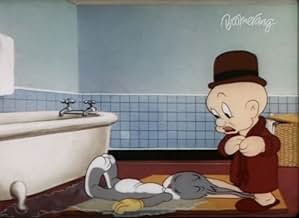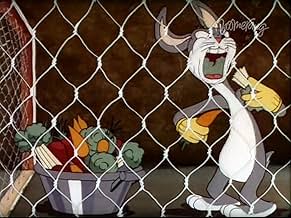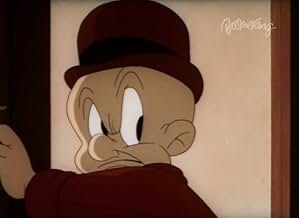अपनी भाषा में प्लॉट जोड़ेंElmer buys a rabbit that he pitied seeing in the pet store. The rabbit turns out to be Bugs and makes Elmer's life a living nightmare.Elmer buys a rabbit that he pitied seeing in the pet store. The rabbit turns out to be Bugs and makes Elmer's life a living nightmare.Elmer buys a rabbit that he pitied seeing in the pet store. The rabbit turns out to be Bugs and makes Elmer's life a living nightmare.
- निर्देशक
- लेखक
- स्टार
Mel Blanc
- Bugs Bunny
- (वॉइस)
- (बिना क्रेडिट के)
Arthur Q. Bryan
- Elmer Fudd
- (वॉइस)
- (बिना क्रेडिट के)
फ़ीचर्ड समीक्षाएं
This is a very, very early Bugs Bunny cartoon. As a result, the character is still in a transition period--he is not drawn as elongated as he later was and his voice isn't quite right. In addition, the chemistry between Elmer and Bugs is a little unusual. Elmer is some poor sap who buys Bugs from a pet shop--there is no gun or desire on his part to blast the bunny to smithereens! However, despite this, this is still a very enjoyable film. The early Bugs was definitely more sassy and cruel than his later incarnations. In later films, he messed with Elmer, Yosimite Sam and others because they started it--they messed with the rabbit. But, in this film, he is much more like Daffy Duck of the late 30s and early 40s--a jerk who just loves irritating others!! A true "anarchist" instead of the hero of the later cartoons. While this isn't among the best Bug Bunny cartoons, it sure is fun to watch and it's interesting to see just how much he's changed over the years.
I agree with a lot of the comments: this Bugs is different. After "A WILD HARE" by Tex Avery, this cartoon seems to be presenting some sort of "cousin" to Bugsy rather than the real thing. I noticed something very weird here: No BUCK TEETH!!! Not to mention this guy spoke in a different voice. Elmer is lovable and actually so is this strange bunny who wears yellow gloves, not white. He has some really funny moments. He does his share of highjinks and heckling, but still, this just isn't the Bugs we all know. So I have a suggestion: either they were still not sure who he was, or maybe he was trying to have some "range" of character!!!
Not a terrible member of the body of work I love, but not my fave either.
Not a terrible member of the body of work I love, but not my fave either.
This very unusual early teaming of Elmer Fudd and Bugs Bunny (long before he found his "voice") is of interest to hardcore fans, though it would be a while before they became the well-oiled machine...
One would think that after the theatrical success and response the first Bugs Bunny cartoon, "A Wild Hare," generated that the Termite Terrace boys would follow it up with something even--pardon the pun--"wilder" for their new star.
However, that does not seem to be case with "Elmer's Pet Rabbit." Unlike the first encounter between Bugs and Elmer in which Bugs knows from frame one how it will end, in this one the control between the two characters shift back and forth. In one scene Bugs has one-upped Elmer, in the next Elmer is throwing him out. Bugs seems less confident, which at times makes it hard for the audience to really root for him.
This is most surprising when one considers that it was scripted by Rich Hogan, who wrote the previous "A Wild Hare." Not surprising, however, is that this slow ordeal was directed by Chuck Jones. Sure, he has conceived some of Bugs' grandest films in the 1950's, but at 1941 Jones was still concentrating on micro-directing...slowing down every action to a crawl so that you pick up every detail, every twitch and expression, and every aside. 1941's Jones was not the man to follow wildman Tex Avery.
And of course, Bugs is still growing into his true self at this point. It could be speculated that "Pet Rabbit" was in production before or at the same time of "A Wild Hare," because how else can one explain the slushier pre-Bugs baritone voice Mel Blanc uses for the wabbit?
As a Bugs cartoon, this one is only for completists. As a non-Bugs cartoon, it is simply slow and pointless.
However, that does not seem to be case with "Elmer's Pet Rabbit." Unlike the first encounter between Bugs and Elmer in which Bugs knows from frame one how it will end, in this one the control between the two characters shift back and forth. In one scene Bugs has one-upped Elmer, in the next Elmer is throwing him out. Bugs seems less confident, which at times makes it hard for the audience to really root for him.
This is most surprising when one considers that it was scripted by Rich Hogan, who wrote the previous "A Wild Hare." Not surprising, however, is that this slow ordeal was directed by Chuck Jones. Sure, he has conceived some of Bugs' grandest films in the 1950's, but at 1941 Jones was still concentrating on micro-directing...slowing down every action to a crawl so that you pick up every detail, every twitch and expression, and every aside. 1941's Jones was not the man to follow wildman Tex Avery.
And of course, Bugs is still growing into his true self at this point. It could be speculated that "Pet Rabbit" was in production before or at the same time of "A Wild Hare," because how else can one explain the slushier pre-Bugs baritone voice Mel Blanc uses for the wabbit?
As a Bugs cartoon, this one is only for completists. As a non-Bugs cartoon, it is simply slow and pointless.
Probably the two main significances of "Elmer's Pet Rabbit" are that the wacky leporid featured in "A Wild Hare" now has a name, and that he utters his famous "Of course you realize this means war!" for the first time. Mostly, the Termite Terrace crowd was still trying to figure out what exactly to do with this long-eared rascal. It's certainly a must-see for hard-core fans of this genre, but others will probably have little reason to take interest.
But make no mistake, it's quite hilarious what Bugs Bunny does to the eternally gullible Elmer Fudd. Clear shades of things to come abound throughout the cartoon. I recommend it.
But make no mistake, it's quite hilarious what Bugs Bunny does to the eternally gullible Elmer Fudd. Clear shades of things to come abound throughout the cartoon. I recommend it.
क्या आपको पता है
- ट्रिवियाThis was the first cartoon in which Bugs Bunny had a name.
- गूफ़After buying Bugs, as Elmer is walking home, he passes the same exact storefront and blurry sign 5 times.
- भाव
Bugs Bunny: [Elmer turns on the light to his bedroom - Bugs is in his bed 'sleeping']
[yells]
Bugs Bunny: Turn off that light!
- कनेक्शनEdited into The Wabbit Who Came to Supper (1942)
- साउंडट्रैकThe Fountain in the Park
(1884) (uncredited)
aka "While Strolling Through the Park One Day"
Written by Ed Haley
Sung by Arthur Q. Bryan as Elmer Fudd
टॉप पसंद
रेटिंग देने के लिए साइन-इन करें और वैयक्तिकृत सुझावों के लिए वॉचलिस्ट करें
विवरण
- रिलीज़ की तारीख़
- कंट्री ऑफ़ ओरिजिन
- आधिकारिक साइट
- भाषा
- इस रूप में भी जाना जाता है
- El conejo mascota de Elmer
- उत्पादन कंपनी
- IMDbPro पर और कंपनी क्रेडिट देखें
- चलने की अवधि8 मिनट
- ध्वनि मिश्रण
- पक्ष अनुपात
- 1.37 : 1
इस पेज में योगदान दें
किसी बदलाव का सुझाव दें या अनुपलब्ध कॉन्टेंट जोड़ें





















